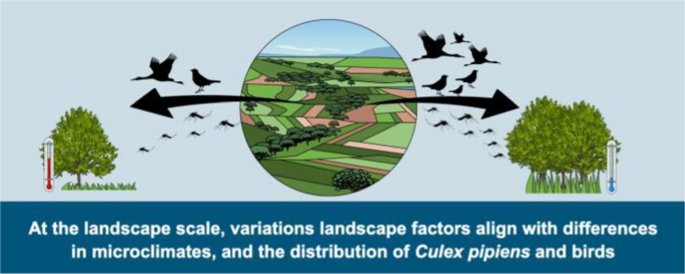Landscape level associations between birds, mosquitoes and microclimates: possible consequences for disease transmission?

This publication is part of the project ‘Preparing for vector-borne virus outbreaks in a changing world: a One Health Approach’ (NWA.1160.1S.210) which is (partly) financed by the Dutch Research Council (NWO).
Authors: Louie Krol, Laure Remmerswaal, Marvin Groen, Jordy G. van der Beek, Reina S. Sikkema, Martha Dellar, Peter M. van Bodegom, Gertjan W. Geerling & Maarten Schrama
Abstract
Background
Mosquito-borne diseases are on the rise. While climatic factors have been linked to disease occurrences, they do not explain the non-random spatial distribution in disease outbreaks. Landscape-related factors, such as vegetation structure, likely play a crucial but hitherto unquantified role.
Methods
We explored how three critically important factors that are associated with mosquito-borne disease outbreaks: microclimate, mosquito abundance and bird communities, vary at the landscape scale. We compared the co-occurrence of these three factors in two contrasting habitat types (forest versus grassland) across five rural locations in the central part of the Netherlands between June and September 2021.
Results
Our results show that forest patches provide a more sheltered microclimate, and a higher overall abundance of birds. When accounting for differences in landscape characteristics, we also observed that the number of mosquitoes was higher in isolated forest patches.
Conclusions
Our findings indicate that, at the landscape scale, variation in tree cover coincides with suitable microclimate and high Culex pipiens and bird abundance. Overall, these factors can help understand the non-random spatial distribution of mosquito-borne disease outbreaks.
Graphical Abstract

Background
Over the past decades, mosquito-borne diseases caused by pathogens such as viruses and parasites have become more prevalent and are spreading to new geographic areas [1, 2]. Climate change is commonly regarded as an important driving factor [3, 4]. Higher temperatures and more erratic rainfall patterns are generally linked to more beneficial conditions for mosquito development and virus replication [5, 6]. While large-scale climatic factors are strongly linked to seasonality and inter-year variation in mosquito-borne disease outbreaks, these predictors are not sufficient to explain the far from random spatial occurrence of mosquito-borne disease outbreaks. These are often confined to certain areas or emerge at the same locality year after year, suggesting that landscape factors play an important role [4, 7, 8]. This calls for a better understanding of the spatial variables that drive outbreaks.
A number of factors related to mosquito-borne disease transmission have been proposed to explain the spatially non-random occurrence of mosquito-borne disease outbreaks, such as suitable microclimate, locally present high number of disease vectors, and a high numbers of amplifying hosts [9,10,11,12,13,14,15,16,17]. First, suitable microclimate for vectors, hosts and virus replication: it is known that temperature and relative humidity play an important role in mosquito survival and virus replication [5, 6, 18,19,20]. At the landscape scale, high vegetation structure such as forests may play an important role in modifying microclimatic conditions such as temperature, humidity and wind speed by acting as a buffer [21, 22]. Vegetation also provides shelter against predators and stimulates non-flight movement which may lead to increased biting rates [23]. Second, locally present high numbers of disease vectors have been linked to spatial attributes and have been hypothesised to facilitate disease spread via the increased likelihood that an infected host gets bitten [16, 24, 25]. For example, high abundance of adult mosquitoes has previously been linked to forest fragmentation or availability of larval breeding habitat (e.g., grassy temporal water bodies) [26,27,28]. Third, high numbers of amplifying hosts for mosquito borne pathogens are important for mosquito-borne diseases transmitted by ornithophilic mosquito species, such as Culex pipiens and, as such, bird abundances and community composition may be of importance to its distribution and relation with pathogens [29,30,31,32,33]. Bird abundances can vary greatly across the landscape because of differences in habitat preferences, food availability and migratory behaviour [34,35,36,37]. Resident (sedentary) birds remain in the same area year round and can serve as both amplifying hosts and reservoirs within their home range, while migratory birds can introduce new arboviruses to a geographic area [29, 38,39,40,41,42]. How these factors vary across the landscape, and whether they co-occur or rather exclude each other at the landscape scale, is currently not well understood.
Here we aim to explore how these three factors, microclimate, mosquito abundance and bird communities, vary and co-occur at the landscape scale. To this end, we investigated these factors in two contrasting habitat types (forests vs. grasslands) in the relatively flat but mosaic-like landscape in the central part of the Netherlands, which mostly consists of small pockets of forest interspersed with water-rich meadows [43]. In this study we focussed on Culex pipiens/torrentium (hereafter Cx. pipiens), which is the most common and abundant mosquito (Culicidae) species in Northwestern Europe and also the primary vector for the transmission of both Usutu virus (USUV) and West Nile virus (WNV) [30, 44,45,46,47,48,49,50]. This unique setup allows us to study how the abovementioned factors—microclimate, mosquito abundances and host communities—vary in relative isolation of variation in macroclimatic factors.
Read the whole publication here.